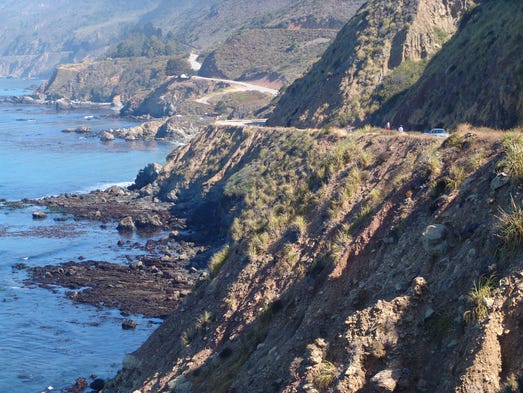For several years now I’ve worried that I’ve lost my inner compass, that I’ve become a GPS addict.
That’s why I said no to the navigation option on my new car a year ago. I’d become that person who never looked at maps and drives like a zombie from here to there.
In foregoing the navigation, I also had visions of resurrecting the old-time ways of getting around— recalling landmarks (“go left at the Methodist church”), and planning a trip by arguing over a paper map with a friend. (“No, we need to go this way!”)
I’m not entirely foolhardy, of course: In case of emergency, I always had my iPhone, with its built-in maps and ride-on-demand apps. My phone was my insurance policy.
Alas, my backup plan didn’t help me recently when I found myself lost in Los Angeles — completely adrift —with no battery life left. Without my iPhone I couldn’t call Fred, who I had planned to meet for dinner, to say I’d be late. (Never mind that while we’ve been friends for two decades, I had no idea what his cell number was.)
Nor had I paid attention to the name of the restaurant he’d texted me earlier. Which didn’t matter much, since I had no way to get there, anyway. I couldn’t request an Uber, and I couldn’t even get a taxi to pick me up without providing a phone number to confirm my location.
It wasn’t always this way.
I wasn’t always this way.
In 1976 I’d managed to fly from New York to Luxembourg, catch a train to Paris and meet my friend Gail at our pre-designated hotel on New Year’s Eve. We’d made our plan weeks earlier — talking on a landline before she flew overseas — et voilà, our adventure unfolded as planned. (Had there been a flight change or train delay, I actually knew the name of the hotel.)
In those days, I lived the aphorism, “It’s the journey, not the destination,” especially as I drove between college in North Carolina and home in New York City. Interstate 95 was direct and fast, but the merest wink of a roadside sign could lure me off the highway to explore a little town, a botanical garden or a historical monument.
With my gas station map I would trace a path through unknown lands, eventually finding my way back to the Interstate. When road signs failed me, I relied on my senses. I knew where the sun rose and set; I most certainly did not need a phone’s “compass” feature to find true north.
When I did get lost, I was late — but so what? My diversions were rich in the unexpected, and I paid attention to the world around me. I might stop and ask a complete stranger for directions, which more often than not led to unexpected conversations. One impromptu chat with a farmer near Dobson, N.C., led this city boy to a short stint working on a farm castrating pigs.
In fact, I loved getting lost so much that in the 1980s, my friend Kurt and I set off on a series of road trips with just that goal. We’d drive over the San Francisco Bay Bridge toward Oakland, then make a predetermined succession of rights and lefts, stopping only when our stomachs growled. One memorable trip took us to the historic town of Benicia, where we ate lunch at the famed Union Hotel. Delicious. Another dumped us at an oil refinery. Oh well.
By midlife, I didn’t have time for such adventures. Instead, I focused on getting to my destination quickly. I blindly followed my car’s GPS navigator without paying attention to my surroundings. Since I never turned on my brain’s own map, I couldn’t find my way back to the same location a second time. I’d become like the Steve Carrell character in The Office, in which the GPS orders him to drive his car right into a lake.
I rarely made a wrong turn, but I couldn’t find my way.
For guidance, I called Nora Newcombe, a professor at Temple University and an expert on spatial navigation. She explained that when we use GPS, we don’t “build up a primitive cognitive map.” Where is the lake? The river? “You don't even know where north is,” she bluntly stated. “You’re just lost.”
More: This new smartphone feature should be used by every driver, from teen to seasoned commuter
More: 11 tips on planning a great family road trip
More: Top-rated pit stops along popular road-trip highways
My Los Angeles adventure brought it all home for me. After lunch one day, my friend Fred and I split on separate pursuits. With the meeting done, a colleague volunteered to drive me to a nearby Von’s grocery store to pick up a bottle of wine. With my battery life fading fast, I texted Fred: “Just getting stuff at Vons. Then will Uber home” to our Airbnb, whose address was in my phone but not my brain.
In the seeming blink of an eye my iPhone died, and I realized the consequences of my laziness: Not memorizing phone numbers. Not registering the restaurant name. Not even remembering exactly where I was staying. Not knowing where I was. Not being present in my own experience.
As I head out for my next road trip, I’ll bring along an old-style map to plot my route. I’ve also stashed the phone numbers of my “favorite” friends in my wallet — just in case battery failure strikes twice.
Alas, I am aware that no solution is perfect. A few weeks ago, driving at dusk, I turned to my paper map (which I’d printed out from MapQuest with just a wee sense of irony). With the light fading and my eyesight no longer in its prime, I couldn’t read the map (nor could I use two fingers to enlarge it). In a moment of near-panic, I turned to my iPhone, which quickly corrected my course and got me safely to my destination.
At least I didn’t get sunk in a frigid lake.
The Takeaway
Plan your next trip on an old-fashioned map so that you can visualize where you’re going.
Try memorizing the directions so that you can pay attention to the sights and scenes (and road signs) on your trip.
Stop and ask for directions, staying in public and only when it feels safe. Not all strangers have your best intentions at heart.
Turn off the audio to your GPS navigation, suggests Temple University’s Newcombe. The visual navigation is much “less pernicious” to your cognitive mapping function, she says.
Orient yourself. Know where north is. Or whether the lake is to the east or west.
Have a backup charger for your phone. Don’t rely 100% on your phone for contact information. Print out a cheat sheet of important numbers and store them in the glove compartment or in a wallet or bag.
Happy trails.
Petrow: Delete yourself from the Internet's people finder sites: Is it worth it?
Petrow: You're sharing your cell phone number too frequently
More: Ask yourself this before posting online about illness
USA TODAY columnist Steven Petrow offers advice about living in the digital age. Submit your question at stevenpetrow@gmail.com. You can also follow Petrow on Twitter: @StevenPetrow. Or like him on Facebook at facebook.com/stevenpetrow.
































































































































































Join the Nation's Conversation
To find out more about Facebook commenting please read the Conversation Guidelines and FAQs